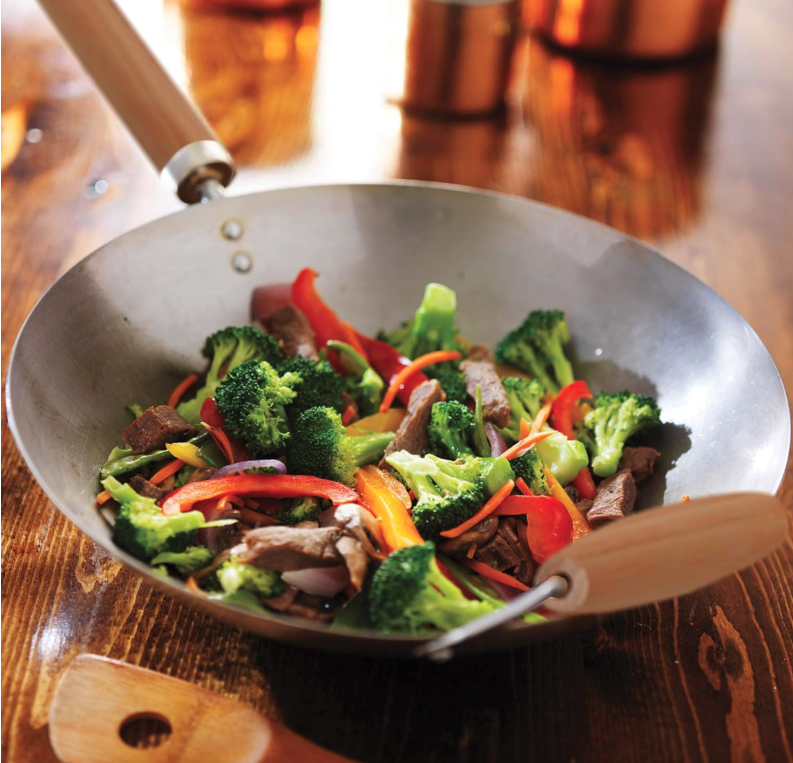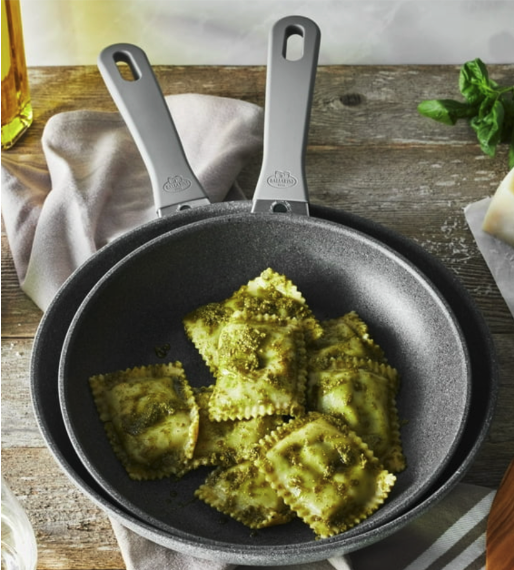Paige Knight - 06 / Mar / 2024
Types of Cookware
Trying to find the right cookware for you? Learn about the different cookware materials, from stainless steel to non-stick, and how to put them to work for you.

When it comes to the best type of cookware, opinions are varied. Some swear by cast iron for its durability and heat retention, while others live and die by stainless steel for its versatility. Ultimately, there is no “best” cookware. The best cookware for you is the type that meets your unique needs and that might mean creating a collection with a variety of cookware types and materials.
Every day, our team helps customers to make informed decisions when shopping for cookware. Whether you’re shopping in store or online we want you to have all the information you need to make the best choices.. That’s why we’ve created this handy guide to the most common types of cookware. Read along and we’ll walk you through the pros and cons of different cookware materials and how they’re used in a variety of cooking applications.
Cookware Materials
One of the most important considerations when choosing a type of cookware is the material that it is made of. It can be tempting to search for the “best” material, but cookware is only as good as the applications you use it for. For instance, if you judge a cast iron skillet by how well it makes a delicate sauce, you’re sure to be disappointed.
That’s why we recommend learning about the types of cookware materials so that you can build a well-rounded collection. Instead of choosing just one material and building around it, we recommend including a variety of different cookware types and materials that meet your unique cooking needs. Before we dive into the different cookware materials, here’s a handy chart with the basics:
| Material | Pros | Cons |
| Stainless Steel |
|
|
| Carbon Steel |
|
|
| Cast Iron |
|
|
| Traditional Non-Stick |
|
|
| Ceramic Non-Stick |
|
|
Best All-Rounder: Stainless Steel
Stainless steel has a high Chromium and Nickel content. In our knife steel blog, we mention that Chromium is the element most responsible for giving steel anti-corrosive qualities. In essence, it’s what makes a steel “stainless.”
Stainless steel is prized as a highly durable and anti-corrosive material. It will last many years, potentially a lifetime, when well cared for, and it’s compatible with a variety of cooking surfaces. However, some struggle to use this material when making more delicate foods, like eggs.
Stainless Steel Cookware Pros
We say that stainless steel is the best all-rounder material because of its high level of versatility. Stainless steel is dishwasher, stovetop, oven, broiler and induction safeIt’s non-reactive with acids and minerals found in many foods. It’s also easy to clean thanks to its smooth, non-porous surface, though we recommend using a softer sponge to avoid scratches.
Stainless steel clad cookware excels at heat distribution, making it perfect for tasks – like searing and sauteing – that require heat to be spread evenly and quickly. Stainless steel is also environmentally friendly as it’s a recyclable material that can be salvaged to create new products even if your cookware gets damaged.
Stainless Steel Cookware Cons
Though stainless steel is highly versatile, it isn’t great for every task. This material is excellent for sauteing, browning, deep frying and boiling, but it can be tricky when cooking delicate foods. The three most common foods people struggle with are eggs, tofu, and lean meat.
Similarly, stainless steel, by itself, isn’t the best heat conductor. Luckily, cookware manufacturers have found a way to side-step this problem by pairing stainless steel with other materials, like copper and aluminum. Layers of stainless steel are bonded to these more conductive materials to create stainless steel “clad” cookware that is both conductive and durable. Only the stainless steel is in contact with the food.

Le Creuset’s Stainless Steel Fry Pan is a great option for your go-to skillet.
Cooking With Stainless Steel
The durability and conductive qualities of stainless steel clad cookware make it a great choice for the most-utilized pieces in a cookware collection. Cookware made with this material can undergo frequent use with minimal wear, making it a great long-term investment that is well-worth the cost. Common types of stainless steel cookware include:
- Skillets: Perfect for frying, browning, scrambling, sauteing and searing.Skillets have a rounded shape with moderately high, gently sloping sides, allowing cooks to toss foods for even cooking. Brands like All-Clad Cuisinart, Made In, and Le Creuset are known for their stainless steel skillets.
- Saute Pans:Saute pans feature higher sides and flatter bottoms than traditional skillets, giving them more surface area for cooking and a greater capacity for liquids. These are perfect for one-pan meals.All-Clad Cuisinart is known for their stainless steel saute pans.
- Saucepans:Saucepans have high sides and narrow bases that allow liquid to be heated from all sides. As the name suggests, these are great for making sauces and simmering liquids. Brands like All-Clad Cuisinart, Made In, RSVP International, and Le Creuset are known for their stainless steel saucepans.
- Stock Pots: These are the largest cooking pots, with tall walls that can hold large volumes of liquid. Stock pots are ideal for cooking stocks, soups, pasta, and seafood. Brands like All-Clad, Cuisinart, Made In, RSVP International, and Le Creuset are known for their stainless steel stock pots.
Best for High Heat: Carbon Steel and Cast Iron
Copper and aluminum are some of the most conductive materials, commonly used as the core for stainless steel cookware, but carbon steel and cast iron aren’t far behind. Both of these materials are able to reach a high temperature and hold it well, making them ideal for high-heat cooking.

Staub’s Classic 7 Quart Cocotte comes in a variety of striking colors that will add a pop to your kitchen. It can even be used to make Crusty Rosemary Bread and Lasagna Soup.
Carbon Steel and Cast Iron Pros
As we’ve mentioned, both of these materials are great for high heat cooking due to their high level of conductivity. They’re also highly versatile, able to be used on a variety of heat sources, including the oven, broiler and induction stovetops. Both have non-stick capabilities when they’re seasoned properly, giving them an edge over stainless steel when cooking more delicate foods.
Cast iron is an especially durable material that will resist warping, denting and chipping, lasting a lifetime if properly cared for. It comes in both traditional and enameled styles and is self-regulating, meaning that it can hold its temperature well and won’t produce temperature spikes. However, if you are looking for a less expensive alternative, carbon steel is a good option.
Carbon Steel and Cast Iron Cons
Despite being able to tolerate high heat, both of these materials are slow to heat and cool, so make sure to preheat them before cooking. They’re also heavy and prone to rusting if not properly seasoned or re-seasoned. Even seriously rusted pans can be restored and reseasoned.
Unlike cast iron, carbon steel is known to be reactive with highly acidic foods over extended cooking times, so you’ll need to be careful about what you cook using this material. Cast iron, on the other hand, can be prone to uneven heating and hot spots when used on a small burner, so be sure to use it on a consistent heat source.
Cooking With Carbon Steel and Cast Iron
Both of these materials are slow to heat, meaning they’re not as good for precision as stainless steel clad cookware. However, their ability to tolerate high heat makes them great for high-heat tasks, like searing steaks and blackening fish.

Smithey’s Carbon Steel Farmhouse Skillet strikes the perfect balance between style and function.
Carbon steel is especially good for stir frying and is often used when making specialty skillets and enameled cookware, like tea kettles. Cast iron’s self-regulating quality makes it great for slow cooking roasts, short ribs, and pork shoulder. Common types of carbon steel and cast iron cookware include:
- Skillets: Carbon steel and cast iron are especially good for searing and browning, making them a great material for skillets. Skillets made using this material tend to be heavier and harder to maneuver than stainless steel, but they can tolerate higher heat and are more non-stick. Lodge Manufacturing and Staub are known for their cast iron lines, while Smithey Ironware Company offers both carbon steel and cast iron skillets.
- Dutch Ovens: Also known as cocotte pots, dutch ovens are heavy wide pots with tight-fitting lids. They’re good for slow cooking because they can maintain a constant temperature for a long time, cooking food evenly. Brands like Le Creuset, Lodge Manufacturing, Smithey Ironware Company, and Staub are known for their cast iron dutch ovens.
- Braisers: Braisers are designed to provide steady, even heat to tenderize tough cuts of meat and veggies. With a wide base that allows for even searing and a domed lid that circulates steam to lock in moisture, this cookware is ideal for shallow frying, steaming, and making stews. Le Creuset is known for its cast iron braisers.
- Woks: A wok is a type of Asian cookware that has a deep bowl and steep, high walls. Woks are ideal for stir frying as they’re able to cook food quickly with a high, even heat distribution. Helen’s Asian Kitchen is known for their carbon steel woks.

Helen’s Asian Kitchen’s 12” Carbon Steel Wok is perfect for all of your stir fry needs.
Best for Convenience: Non-stick
Non-stick cookware is versatile and convenient for the everyday cook, but it should be treated with care. It comes in two varieties: PTFE (polytetrafluoroethylene) and ceramic. PTFE is the classic material used for non-stick cookware because it is highly functional, but it also carries a legacy of safety concerns from long ago, when PFOA (perfluorooctanoic acid) was used in the manufacturing of coated pans.
PTFE is generally safe when used correctly and not overheated, but some concerns exist about potential off-gassing at very high temperatures. PFOA, once used in the manufacturing process of some nonstick coatings, is NO LONGER USED in the US, Europe, and Japan due to health concerns. To learn more about whether or not PTFE-based non-stick cookware is really as dangerous as its history suggests, check out our non-stick myths blog.
Ceramic non-stick cookware is a popular alternative with a better reputation. It’s more environmentally friendly and doesn’t bear the same history of safety issues that traditional non-stick cookware carries. Ceramic pans can also achieve a higher heat point without releasing toxic fumes, though doing so will degrade it over time.
Non-stick Cookware Pros
Non-stick cookware is prized by many for its convenience and versatility. It’s lightweight, affordable and easy to clean. Non-stick cookware also boasts health benefits, as nonstick coatings reduce the need for oil and butter. This material is used to make a wide variety of cookware, making it perfect for everything from sauteing and gently browning meats and vegetables to simmering liquids.
Non-Stick Cookware Cons
While non-stick cookware is highly versatile and convenient, it’s not as durable as the other options we’ve discussed. Non-stick coatings only work when fully intact, but they can be prone to scratching, scuffing, and warping if not cared for properly. That’s why we recommend steering clear of sharp utensils and abrasive sponges to ensure your coating remains intact.
Similarly, non-stick cookware is far less tolerant of heat. While ceramic cookware can reach a higher heat, traditional non-stick pans cannot be used above temperatures of 400°F (204°C) without their coating breaking down, so we recommended avoiding high-heat cooking applications. Some of these pans are also limited when it comes to cooking surfaces, so be sure to check the use instructions before using a non-stick pan in the oven or on an induction stovetop.

Ballarini’s Non-Stick Fry Pan is perfect for delicate cooking tasks.
Cooking With Non-Stick
Non-stick cookware is a versatile and convenient choice for cooks of all levels, from home cooks to professional chefs. It’s ideal for cooking delicate foods, such as eggs and seafood, that are more likely to stick to stainless steel cookware. We recommend building a few non-stick pieces into your existing cookware collection according to your unique needs. Non-stick cookware is also a great option for college students, people on a budget, or beginner home cooks. Common types of non-stick cookware include:
- Skillets: Non-stick skillets are great for delicate tasks, like frying eggs and cooking seafood. Brands like Ballarini, Cuisinart, Zwilling, Demeyere, and The Cookware Company are known for their non-stick skillets.
- Saucepans: Non-stick saucepans offer a lightweight, convenient way to cook sauces, oatmeal and rice. Zwilling’s Ballarini is known for their non-stick saucepans.
Picking The Right Cookware for You
Every day, people come into Blackstone’s of Beacon Hill wondering what type of cookware is best for them. We talk about the foods they cook, their lifestyle, their budget and everything in between to find the perfect fit for each person’s unique needs. No two peoples’ cookware collections will look exactly the same because no two peoples’ lives look exactly the same. Cookware is as varied and nuanced as the people that use it, but this article is a good first step toward finding the perfect pieces for you.
If you’re still feeling slightly overwhelmed or stumped, stop by our Boston location at 40 Charles Street to chat with our knowledgeable staff. We’ll give you the individual attention you deserve so you can go home with your perfect cookware piece, or a whole collection. If you don’t live in the area, no worries! Check out the Blackstones website to read our other blogs and view our wide variety of kitchenware, home decor, and gifts.










